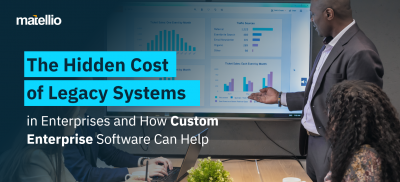
The Technology, Media, and Telecommunications (TMT) sector is characterized by rapid innovation and the need to deliver high-performance, scalable, and agile solutions. To stay competitive, companies in this sector must adopt cutting-edge technologies that allow for quick adaptation to market changes, efficient handling of large-scale data, and seamless delivery of services. This blog explores how Cloud-Native Architecture can transform TMT solutions by providing a flexible, scalable, and resilient foundation.
Advantages of Cloud-Native Architecture
Enhanced Scalability
- Dynamic Scaling: Cloud-native applications can easily scale horizontally by adding more instances of services as needed. This ensures applications can handle varying levels of demand efficiently.
- Elasticity: Automatically adjust resources in real-time based on workload, reducing the risk of over-provisioning or under-provisioning.
Improved Agility
- Rapid Iteration: Development teams can iterate on individual microservices independently without impacting the entire application, enabling faster deployment of new features and updates.
- Shorter Development Cycles: Microservices architecture allows for parallel development, accelerating time-to-market.
Resilience and Fault Tolerance
- Service Isolation: Cloud-Native Architecture for TMT is designed to handle failures gracefully. If a microservice fails, others continue to function, minimizing downtime.
- Self-Healing: The use of orchestration tools like Kubernetes ensures automatic recovery from failures, maintaining application stability.
Resource Efficiency
- Containerization: Containers allow for efficient use of resources by running multiple isolated services on the same hardware, reducing overhead and costs.
- Optimal Utilization: Containers share the same operating system kernel, maximizing hardware utilization.
Consistency Across Environments
- Uniform Environments: Containers provide a consistent runtime environment, ensuring that applications run the same way in development, testing, and production.
- Reduced Discrepancies: Eliminate environment-specific bugs by maintaining consistency across all stages of the deployment pipeline.
DevOps and CI/CD Integration
- Automated Pipelines: Cloud-native architectures facilitate continuous integration and deployment, enabling automated testing, integration, and deployment pipelines.
- Faster Delivery: Another advantage of cloud-native architecture is its Seamless integration with DevOps tools, which accelerates the development lifecycle and enhances collaboration.
Also Read: Cloud Native Applications: Features, Benefits, and Process
Flexibility and Portability
- Cloud Agnostic: Applications built using cloud-native principles can be deployed across various cloud providers or on-premises, providing flexibility and avoiding vendor lock-in.
- Ease of Migration: Portability across environments simplifies migration between cloud platforms.
Enhanced Security
- Granular Security: Microservices and containers can be individually secured, and tools like Kubernetes offer built-in security features such as secrets management and network policies.
- Isolation: Enhanced security through the isolation of individual services minimizes the attack surface.
Faster Time-to-Market
- Modular Development: The modular nature of cloud-native applications allows for quicker telecom software development cycles and faster deployment of new features.
- Incremental Updates: Deploy updates to specific microservices without redeploying the entire application.
Better Observability
- Comprehensive Monitoring: Cloud-native environments often include tools for monitoring and logging, providing better visibility into the health and performance of applications.
- Proactive Issue Detection: Advanced observability tools enable early detection and resolution of issues.
Automated Management
- Orchestration Tools: Tools like Kubernetes automate many aspects of managing containerized applications, such as scaling, updates, and recovery.
- Simplified Operations: Automated processes reduce manual intervention, streamlining operations.
Improved Collaboration
- Shared Responsibility: Cloud-native architecture practices encourage collaboration between development and operations teams, fostering a culture of shared responsibility and continuous improvement.
- Enhanced Communication: Tools and practices that promote transparency and cooperation improve team dynamics.
Environmental Sustainability
- Efficient Resource Use: Efficient resource utilization and scalability reduce the carbon footprint of running applications.
- Energy Savings: Dynamic scaling ensures resources are used only when needed, conserving energy.
Rapid Innovation
- Continuous Deployment: With the ability to quickly deploy and test new features, companies can innovate faster and respond to market changes more effectively.
- Experimentation: Frequent releases allow for experimentation and faster feedback cycles.
Simplified Management
- Centralized Tools: Centralized management tools simplify the deployment, scaling, and monitoring of applications, reducing the complexity of managing large-scale systems.
- Unified Control: Manage multiple services from a single interface, enhancing operational efficiency.
Dynamic Load Balancing
- Efficient Resource Allocation: Automatically distributes incoming traffic across multiple services, ensuring optimal resource utilization and performance.
- High Availability: Load balancing enhances application availability and reliability.
Hybrid and Multi-Cloud Support
- Cross-Cloud Deployment: Cloud-native applications can run across multiple cloud environments, providing flexibility and redundancy.
- Resilience: Multi-cloud support ensures resilience and continuity in case of cloud provider issues.
Enhanced User Experience
- Reliability: Scalable and reliable applications ensure a better user experience with minimal downtime and high performance.
- Performance: Improved application performance leads to higher user satisfaction.
Want To Gain These Perks While Developing TMT Solutions?
Implementing 5G Observability Solutions with Matellio
In a case study by Matellio, a client required enhanced observability for their 5G infrastructure to support a fully mobile and connected society. Matellio’s team developed a solution focused on metrics observability, logging, and tracing. They collected resource utilization metrics, traffic rates, errors, and service durations, which were crucial for monitoring and optimizing the 5G NF observability. This implementation allowed real-time performance analysis and troubleshooting, significantly improving the client’s ability to manage their 5G services effectively.
Detailed Description of the Case Study
Problem Statement:
A leading telecommunications company faced challenges in monitoring and optimizing its 5G infrastructure. They needed a comprehensive observability solution to ensure seamless operation, performance, and reliability of their 5G network services.
Solution Provided by Matellio
Matellio is a media & entertainment software development company that designed and implemented a robust 5G observability solution tailored to the client’s needs. The solution focused on three main areas: metrics observability, logging, and tracing.
Metrics Observability
- Implementation: Matellio integrated a monitoring system that collected detailed metrics related to resource utilization, traffic rates, error rates, and service response times.
- Outcome: This enabled the client to monitor the performance and health of their 5g cloud-native architecture in real time, identifying and addressing potential issues promptly.
Logging
- Implementation: A centralized logging system was developed to aggregate logs from various network components, providing a unified view of all activities within the 5G network.
- Outcome: This enhanced the client’s ability to conduct in-depth analysis of network events, aiding in troubleshooting and ensuring compliance with regulatory requirements.
Tracing
- Implementation: Distributed tracing was implemented to track the flow of requests across the microservices architecture of the 5G network.
- Outcome: This allowed the client to understand the end-to-end journey of data packets, pinpointing bottlenecks and optimizing the performance of individual network functions.
Impact of the Solution 
- Improved Performance: The client experienced significant improvements in network performance and reliability, with real-time insights facilitating proactive management.
- Enhanced Troubleshooting: The comprehensive observability solution enabled quicker identification and resolution of issues, reducing downtime and improving service quality.
- Scalability: The solution was scalable, allowing the client to expand their 5G network without compromising on monitoring and management capabilities.
Ready to Transform Your TMT Solutions With Cloud-native Architecture?
Features of Cloud-Native Architecture
The cloud native architecture features mentioned below collectively contribute to the flexibility, scalability, and resilience of cloud-native applications, making them well-suited for dynamic and large-scale environments typical in the TMT sector.
| Feature | Description |
| Microservices Architecture | Decomposes applications into small, loosely coupled services that can be developed, deployed, and scaled independently. |
| Containers | Encapsulate services in lightweight, portable units that ensure consistent environments across development, testing, and production. |
| Service Mesh | Manages service-to-service communication, providing features like load balancing, service discovery, and security. |
| Dynamic Orchestration | Automates deployment, scaling, and management of containerized applications using tools like Kubernetes. |
| API Management | Facilitates communication between microservices through well-defined, secure APIs. |
| Continuous Integration/Continuous Deployment (CI/CD) | Automates the integration and deployment processes, ensuring rapid and reliable delivery of updates. |
| DevOps Practices | Promotes collaboration between development and operations teams, fostering a culture of shared responsibility and continuous improvement. |
| Serverless Computing | Allows developers to build and run applications without managing infrastructure, automatically scaling based on demand. |
| Observability | Provides comprehensive monitoring, logging, and tracing to gain insights into application health and performance. |
| Scalability | Enables horizontal scaling to handle increased loads by adding more instances of services. |
| Fault Tolerance | Ensures application resilience by isolating failures and enabling self-healing mechanisms. |
| Resource Efficiency | Maximizes resource utilization through containerization, reducing overhead and costs. |
| Security | Incorporates built-in security features like secrets management, network policies, and microservice isolation. |
| Flexibility and Portability | Supports deployment across various cloud providers and on-premises environments, avoiding vendor lock-in. |
| Automated Management | Utilizes orchestration tools to automate scaling, updates, and recovery processes. |
| Hybrid and Multi-Cloud Support | Allows applications to run across multiple cloud environments, providing redundancy and flexibility. |
| Dynamic Load Balancing | Distributes incoming traffic efficiently across services to optimize resource utilization and performance. |
| Self-Healing | Automatically recovers from failures to maintain application stability and minimize downtime. |
| Environmental Sustainability | Promotes efficient resource use and scalability, reducing the carbon footprint of running applications. |
| Rapid Innovation | Facilitates quick deployment and testing of new features, enabling faster response to market changes. |
Emerging Trends and Technologies for Cloud-Native Architecture in the TMT Sector
The TMT sector is rapidly evolving, driven by advancements in cloud-native architecture. You can leverage the technology consulting services from the experts of reputed development companies and learn more about such trends. Here are the key emerging trends and technologies shaping the future of cloud-native applications in this sector:
 Service Mesh
Service Mesh
A service mesh is a dedicated infrastructure layer for handling service-to-service communication, providing observability, security, and traffic management.
Impact on TMT:
- Enhanced Security: Manages service-to-service encryption, ensuring secure communication.
- Better Observability: Provides detailed metrics, logging, and tracing, which is crucial for monitoring complex microservices architectures.
- Traffic Management: Enables advanced routing, load balancing, and failure recovery, improving application performance and reliability.
 Edge Computing
Edge Computing
Edge computing brings computation and data storage closer to data sources, reducing latency and bandwidth usage.
Impact on TMT:
- Low Latency: Essential for real-time applications like live streaming, online gaming, and IoT devices.
- Improved Performance: Processes data locally, enhancing user experience by reducing delays.
- Scalability: Distributed computing resources across multiple locations, supporting large-scale deployments.
 Multi-Cloud and Hybrid Cloud Strategies
Multi-Cloud and Hybrid Cloud Strategies
Adopting multi-cloud and hybrid cloud strategies and leveraging cloud integration services offers organizations the strengths of multiple cloud providers and integrated on-premises infrastructure.
Impact on TMT:
- Flexibility: Avoids vendor lock-in and provides the ability to choose the best services from different providers.
- Resilience: Enhances disaster recovery and business continuity by distributing workloads across multiple environments.
- Cost Optimization: Allows for better cost management by utilizing the most cost-effective cloud services for different workloads.
 Artificial Intelligence and Machine Learning Integration
Artificial Intelligence and Machine Learning Integration
Integrating AI and ML with cloud-native applications enables advanced telecom analytics, data analytics, automation, and personalized user experiences.
Impact on TMT:
- Personalization: AI-driven recommendations improve user engagement in media and entertainment platforms.
- Automation: Automates network management and operations in telecommunications, reducing operational costs and improving efficiency.
- Predictive Analytics: Helps in forecasting demand, optimizing resource allocation, and enhancing decision-making processes.
 Kubernetes Advancements
Kubernetes Advancements
Kubernetes continues to evolve with new features and enhancements, becoming the de facto standard for container orchestration.
Impact on TMT:
- Simplified Management: New tools and plugins streamline the deployment and management of complex microservices architectures.
- Enhanced Security: Improved security features protect applications and data.
- Increased Scalability: Supports large-scale deployments with ease, which is essential for handling the high demands of TMT applications.
 Continuous Integration and Continuous Deployment (CI/CD)
Continuous Integration and Continuous Deployment (CI/CD)
CI/CD practices automate the software development lifecycle, enabling faster and more reliable application updates.
Impact on TMT:
- Speed: Accelerates development cycles, allowing for rapid feature releases and updates.
- Quality: Automated testing and deployment reduce the risk of errors and ensure high-quality releases.
- Agility: Enables quick response to market changes and customer feedback, fostering innovation.
 Observability and Monitoring
Observability and Monitoring
Advanced observability and monitoring tools provide deep insights into application performance, helping to maintain reliability and optimize resources.
Impact on TMT:
- Real-Time Monitoring: Essential for maintaining high-quality service in live media and telecommunications applications.
- Proactive Management: Identifies and resolves issues before they impact users, ensuring a seamless experience.
- Resource Optimization: Helps in efficient resource utilization, reducing costs and improving performance.
Wish To Learn More About These Future Trends from Our Experts?
How Can Matellio Help Leverage Cloud-native Architecture for TMT Solutions?
The adoption of cloud-native architecture is transforming the TMT sector by providing scalable, agile, and resilient solutions. However, in order to leverage the different innovative solutions for your business that cater to the TMT sector, you need a trusted partner. This is where Matellio enters!
Matellio, with its expertise in digital transformation services, offers comprehensive support to ensure your TMT solutions are robust, efficient, and future proof.
 Expertise in Cloud-Native Technologies
Expertise in Cloud-Native Technologies
We have a team of experts with a deep understanding of cloud-native technologies, including microservices, containers, and orchestration tools like Kubernetes.
Also Read: Cloud Software Development – Use Cases and Development Process
 Scalable Solutions
Scalable Solutions
By adopting a microservices architecture, Matellio ensures that your TMT applications can scale effortlessly. Whether you need to handle a sudden surge in users or scale down during off-peak times, our cloud-native solutions provide the flexibility to adjust resources dynamically, optimizing performance and cost efficiency.
 Enhanced Agility
Enhanced Agility
Our cloud-native approach, combined with azure integration services, allows for continuous integration and continuous deployment (CI/CD), enabling rapid development and deployment cycles. This agility ensures that new features and updates can be rolled out quickly, keeping your TMT solutions at the cutting edge of innovation.
 Improved Resource Efficiency
Improved Resource Efficiency
Leveraging containerization, our team ensures that your applications run efficiently across various environments. This approach maximizes resource utilization and reduces overhead, lowering operational costs and enhancing the performance of your TMT solutions.
 Robust Security
Robust Security
Security is paramount in the TMT sector, Matellio integrates advanced security features into your cloud-native architecture, such as secrets management, network policies, and service isolation. This comprehensive security framework ensures that your applications are protected against potential threats. With the right telecom project management software, you can further enhance your project workflows while maintaining robust security across all operations.
Connect with our experts today to discover how our cutting-edge cloud-native solutions can transform your TMT applications, ensuring they are equipped to meet the demands of today and the challenges of tomorrow. To learn more about the same, you can connect with our experts by filling out the form!
FAQs
Q1. Can cloud-native architecture be integrated with existing TMT infrastructure?
Yes, cloud-native architecture can be integrated with existing TMT infrastructure. Our team has extensive experience creating hybrid cloud solutions seamlessly integrating on-premises systems with cloud-native applications. This approach allows TMT companies to leverage the benefits of cloud-native technologies while preserving their investments in existing infrastructure.
Q2. What are the costs associated with developing and implementing a cloud-native TMT solution?
The costs of developing and implementing a cloud-native TMT solution depend on the project's complexity, the specific technologies used, customization requirements, and integration needs. We provide transparent and detailed cost estimates tailored to each client's needs, ensuring a high-quality solution that aligns with your budget and strategic objectives.
Q3. What support and maintenance services are offered for cloud-native TMT solutions?
Comprehensive support and maintenance services are offered for cloud-native TMT solutions. These services include 24/7 technical support, regular updates, performance optimization, and proactive monitoring. Our dedicated team ensures that your cloud-native applications run smoothly and remain up to date with the latest technological advancements.
Q4. How is data migration to cloud-native architecture handled for TMT companies?
A structured and secure approach to data migration ensures minimal disruption and data integrity. The process includes thorough planning, data assessment, and testing phases to ensure a smooth transition to a cloud-native architecture. Robust backup and recovery solutions are also provided to safeguard data throughout the migration process.
Q5. Can cloud-native solutions be customized to meet the specific needs of TMT companies?
Absolutely. Our specialty is customizing cloud-native solutions tailored to the unique requirements of TMT companies. Whether you need specific functionalities, integration with existing systems, or bespoke workflows, our team works closely to develop a solution that meets your needs and drives your business objectives.

 Service Mesh
Service Mesh Edge Computing
Edge Computing Multi-Cloud and Hybrid Cloud Strategies
Multi-Cloud and Hybrid Cloud Strategies Artificial Intelligence and Machine Learning Integration
Artificial Intelligence and Machine Learning Integration Kubernetes Advancements
Kubernetes Advancements Continuous Integration and Continuous Deployment (CI/CD)
Continuous Integration and Continuous Deployment (CI/CD) Observability and Monitoring
Observability and Monitoring Expertise in Cloud-Native Technologies
Expertise in Cloud-Native Technologies Scalable Solutions
Scalable Solutions Enhanced Agility
Enhanced Agility Improved Resource Efficiency
Improved Resource Efficiency Robust Security
Robust Security

